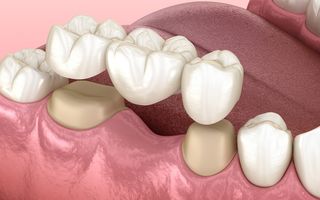Exploring options for a missing tooth

Losing a tooth can be an unsettling experience, whether it happens suddenly or due to long-term dental issues. A missing tooth isn’t just a cosmetic concern—it can impact your ability to chew, speak clearly, and even affect the alignment of your remaining teeth.
The good news is that modern dentistry offers several effective solutions to replace teeth, restore your smile, and protect your oral health.
Why replace missing teeth?
Replacing missing teeth is essential for oral health and overall well-being. Gaps can cause teeth to shift, leading to misalignment, bite issues, and increased risk of gum disease. Missing teeth also affect speech, chewing, and confidence.
By restoring lost teeth, you maintain dental function, prevent further complications, and protect your smile.
Oral functionality and aesthetics
Missing teeth can make chewing and speaking difficult, affecting nutrition and communication. Gaps may also cause facial sagging, impacting appearance and confidence. Replacing missing teeth restores function, maintains facial structure, and allows you to smile with ease.
What happens if you leave a tooth missing?
Many people assume that a tooth missing from their smile is just an aesthetic issue, but the consequences go beyond appearance. If left untreated, a missing tooth can lead to:
- Shifting Teeth – The surrounding teeth may drift into the empty space, leading to misalignment.
- Bone Loss – The jawbone in the missing tooth area will deteriorate over time due to lack of stimulation.
- Bite Problems – Gaps in your teeth can cause an uneven bite, potentially leading to jaw pain or headaches.
- Speech and Chewing Issues – Depending on the location, a tooth missing from your front or back teeth can impact speech clarity and your ability to eat comfortably.
- Tooth Decay – Gaps left by missing teeth can make it difficult to clean existing teeth properly, increasing the risk of developing tooth decay and gum disease over time.
Seeking timely treatment can prevent these complications and improve both your dental function and confidence.
What to do when a tooth falls out
If your tooth fell out due to an accident or injury, follow these steps immediately:
- Find the Tooth – If possible, locate the lost tooth and handle it by the crown (top), not the root.
- Keep It Moist – If the tooth is intact, place it back in its socket, store it in milk, or use a tooth preservation kit. Avoid water, as it can damage root cells.
- See a Dentist ASAP – Timing is crucial—if re-implanted within 30-60 minutes, there’s a chance your natural tooth can be saved.
If reattachment isn’t possible, your dentist will discuss replacement options to restore function and aesthetics.
Best treatment options
Whether your tooth is missing due to injury, decay, or gum disease, there are several teeth replacement solutions to replace teeth effectively:
Dental Implants – the closest to a natural tooth

A dental implant is a permanent and durable replacement for a missing tooth. It consists of a titanium post surgically placed into the jawbone, topped with a custom-made dental crown. Implants:
- Provide a fixed, secure solution
- Restore function and aesthetics
- Are more affordable than implants
Dental bridges - a non-surgical solution

A dental bridge fills the gap left by a tooth missing by anchoring a false tooth to the surrounding existing teeth. Bridges:
- Provide a fixed, secure solution
- Restore function and aesthetics
- Are more affordable than implants
Dentures - an option for multiple missing teeth

If you have more than one tooth missing, a removable partial denture or full dentures may be a good solution. They are removable and help restore the ability to chew and speak clearly.
- Cost-effective for multiple missing teeth
- Quick and non-invasive
- Custom-made for comfortable fit
Implant-supported dentures - stability & strength

For those needing to replace teeth on a larger scale, implant-supported dentures provide more security than traditional dentures by attaching to strategically placed implants.
- Greater stability than removable dentures
- No slipping or discomfort
- Supports jawbone health
Choosing the right tooth replacement option
The best tooth replacement options depend on factors like the number of missing teeth, overall oral health, budget, and long-term goals. Consulting with your dentist will help determine the most suitable option to restore your smile.
Factors to consider
When considering replacing missing teeth, several factors come into play. The location and number of missing teeth are crucial, as they determine the most suitable replacement option. The condition of your remaining teeth and the overall health of your gums and jawbone are also important considerations. For instance, dental implants require a healthy jawbone for the titanium post to be securely placed.
Additionally, the cost of the procedure, the durability of the replacement teeth, and the potential impact on adjacent teeth must be taken into account. Dental implants, while more expensive, offer a long-term solution that mimics natural teeth. Dental bridges and removable partial dentures are more affordable but may require more maintenance and have a shorter lifespan.
Consulting with your dentist will help you weigh these factors and choose the best option for your needs.
Procedure and cost
The cost and procedure for replacing missing teeth vary by treatment:
- Dental Implants: A titanium post is surgically placed in the jaw, with a replacement tooth attached. It’s the most durable but also the most expensive option.
- Dental Bridges: Uses crowns on adjacent existing teeth to support a fixed artificial tooth. Less invasive and more affordable than implants but may not last as long.
- Partial Dentures: A removable partial denture is a cost-effective solution that replaces multiple teeth but may require frequent adjustments.
Each option has benefits and limitations—consult your dentist to determine the best fit for your needs.

